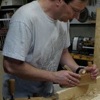Speak for yourself, Adam. C Schwarz' "Coarse, Medium, Fine" opened my eyes to this matter and I've firmly committed to that approach. When my colleague/friend mentioned he received an old 607 for Christmas, I loaned him my DVD and told him he had to watch - "it's important." So there, assuming he's heeded my advice, that's 2 people better off for it (and there just *may* be more
).
To open the aperture just a bit more...about a year ago there was discussion on SMC as well as the SAPFM forum about creating a site devoted to hand-tool only approach. The need was expressed in a similar manner to what's being discussed in this thread. If that site was ever created, I haven't been able to find it. What we're left with is tracking threads like this one that pop up from time to time on SMC and other forums. Additionally, and more compellingly, a loosely coupled collection of blogs have formed which focus on this area. By following the links in each blog I *think* I've discovered the relevant blogs, and I've found that RSS feeds make it handy to track activity across these blogs. But this remains a loosely coupled discussion, and blogs tend to serve a multicast (one-way) function. I think this community of interest deserves better. (Hey, isn't there a magazine out there looking to transform their web presence?)
Maybe, but I get along fine with curmudgeons. My wife would tell you I'm happiest when I have something to complain about.






 Reply With Quote
Reply With Quote



 Jr.
Jr. 
 . The empirical method you describe is much more practical. Like many things in hand-tool work, lay the measuring devices aside, put the pieces together and cut to fit.
. The empirical method you describe is much more practical. Like many things in hand-tool work, lay the measuring devices aside, put the pieces together and cut to fit.